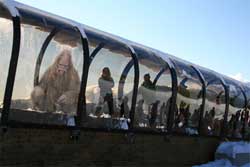The same type of proverb holds true with the sasquatch, rumoured to live on Mount Washington.
In years where a La Nina which correlates to a big snow year – is predicted, Sasquatch instinctively grow their hair longer to handle the colder winters.
There is precedent for this type of thinking, says Norwegian Sasquatch expert, Hans Spilleren Spok.
The manaha, or windigo, found in the Great Lakes region of North America has a long mane of hair. Closer to home, the Arulataq of Alaska is covered in long, flowing hair to counter the subzero temperatures typical of a northern winter.
How do Sasquatch deal with El Nina weather? They change their migratory patterns, Spillern Spok said. Rather than roaming all through Vancouver Island and the Coastal Mountains of British Columbia, as is their practice, they hunker down in one spot.
Backcountry hikers have noticed blowdown debris piled up in strange places. One spotted a tuft of long, thick hair at what could have been construed as the entrance to the pile, leaving cryptozoologists to believe Sasquatch are building themselves dens.
One hiker, who did not want to be identified, said he thought he saw a Sasquatch on the backside of the Sunrise Quad in late October. What made him think it was a Sasquatch and not a black bear, which are also prevalent on the mountain, was the long hair blowing in the wind as the Sasquatch ran across a clear patch and back into the trees.“I sure hope they have somewhere warm to spend the winter,” he said.
